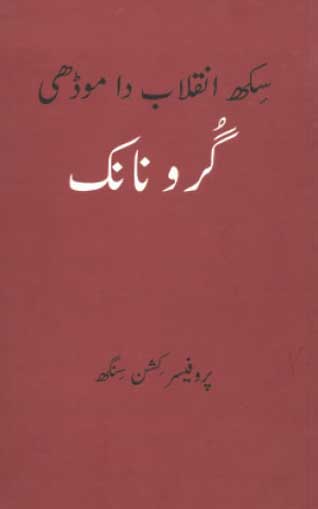Books
Re-Reading Guru Nanak
A Book Review by SARAH KAZMI
SIKH INQUILAAB DA MODHEE — GURU NANAK (Progenitor Of The Sikh Revolution), by Kishan Singh. Punjabi, Suchet Kitan Ghar, Lahore, Punjab, 2017. Transliterated from the original Gurmukhi script to Shahmukhi by Maqsood Saqib, pp 335. ISBN: 978-9695770962.
Following the partition of the subcontinent in 1947, the nascent states of India and Pakistan busied themselves with writing each other out of their national histories.
Punjab was carved up and, in one of the largest movements of population in modern history, reorganised into a Sikh-dominated East Punjab and a Muslim-majority West Punjab.
The new international border crucially re-shaped the Punjabi sense of identity. A process of redefinition of Punjabi culture and history began on both sides of the border to validate the narratives spun by the nationalist movements in Pakistan and India.
In West Punjab, the area’s intellectual heritage began to be communalised under the shadow of the Muslim state, and the rich, multi-religious cultural landscape that wove together the Sikh Gurus, Sufi fakirs, Bhakti sants and Nath jogis was sidelined. To this day, aspects of Punjabi history and culture that threaten to awaken uncomfortable memories of the tragedy of Partition are silenced, and we are presented with a sanitised, Islamised perspective on regional history.
In this context, the publishing of Kishan Singh’s ‘Sikh Inquilaab Da Modhee’ ('Progenitor of The Sikh Revolution') is a welcome move towards reintroducing Pakistani Punjabis to one of the most profound thinkers their land has produced -- the founder of the Sikh faith, Guru Nanak.
The book was originally published in 1970 in East Punjab and has recently been transliterated from the Gurmukhi script by Maqsood Saqib.
Saqib is a Punjabi short story writer and intellectual who also runs the publishing house ‘Suchet Kitab Ghar’ and edits the monthly Punjabi magazine ‘Puncham‘.
In an insightful preface to the book, Saqib introduces us to Professor Kishan Singh. Born in 1911, Kishan Singh completed his MA in English in 1933 and spent the next 43 years of his life as a college lecturer in English language and literature. He began writing in 1950 and, despite his background in English, chose simple, everyday Punjabi to express his shrewd analyses of Punjab’s history and literature.
As much today as it did in the 1970s, Kishan Singh’s book represents a radical departure from the majority of commentaries on Sikh history and Gurbani, which is the collection of poetry contained in the Sikh holy scripture, the Guru Granth Sahib.
The Fifth Master, Guru Arjan, began the process of compiling the Guru Granth Sahib that features poetry from Guru Nanak and Guru Arjan, and many others. However, the Guru Granth Sahib is unique in the history of the world’s spiritual literature in that it does not limit itself to the utterances of the Sikh Gurus, extending its ambit to the verses of Bhagat Kabir and Baba Farid. By the time of the Tenth Master, Guru Gobind Singh, the process of compilation was complete. Guru Gobind Singh declared that he would be the last living Guru and the Granth Sahib was to serve as the eternal Guru henceforth for all time to come.
In post-Partition East Punjab, intellectual activity and research came to focus heavily on Sikh studies, a body of knowledge that viewed Punjab exclusively through a spiritualised, reverential perspective on Guru Nanak and the Sikh religion.
‘Sikh Inquilaab Da Modhee’ unsettles these dominant narratives around culture and popular spirituality in both Punjabs by offering a historical-materialist approach for analysing the Guru Granth Sahib.
Kishan Singh begins his book with a historical sketch of the subcontinent in the middle ages. According to him, society at this juncture was characterised by the feudal mode of production. The primary contradiction was between the landed and the landless, and the medieval state and sultan used their power to uphold the exploitation of the peasant’s labour.
In this context, Guru Nanak, and the succeeding Gurus chose to align themselves with the oppressed and the downtrodden (which included the so-called ‘lower’ castes and classes) and thus became integral to the peasant struggle against the Muslim invaders of Punjab.
Thus, for Kishan Singh, Guru Nanak’s ideology and practice were inseparable from the political resistance of his times and must be viewed as such. This is the basis for Kishan Singh’s literary analysis of Gurbani.
His poetic analysis of Gurbani draws on political history and Marxist theory to move beyond the Guru Granth Sahib’s spiritual representation. He starts, most aptly, with Guru Nanak’s famous ‘Babar Bani’, an epic poem written in the form of the vaar [historical ballad] in the early 16th century. It details the pillage and destruction wrought by Babar’s invasion of the subcontinent, offering a sharp critique of the Mughals.
Drawing on the ‘Babar Bani’, Kishan Singh argues that Guru Nanak’s bani was intensely concerned with political questions, using the otherworldly only as a symbolic lens to illuminate social realities in the here and now. Through his commentary on ‘Babar Bani’, Kishan Singh introduces us to a rich source for alternative history, a subaltern perspective on the Mughal period representing the desires and frustrations of the conquered rather than the conqueror.
Next, Kishan Singh delves into a detailed exploration of symbolism in Gurbani. According to his analysis, the world of Gurbani is defined by the ceaseless fight between “maya” and “naam.” Maya is illusion. Borrowed from the abstruse world of religious philosophy, the word takes on far more material implications in the Guru Granth Sahib.
Maya comes to stand in for the prevalent social and economic system that strips man of his humanity, making him a slave to dispossession and greed. Naam is its opposite. Literally translating to “name,” it connotes the nameless, or the one name that encompasses all names. Kishan Singh interprets naam as the unity of creation, a space where individual identity ceases to exist and collectivity reigns.
Kishan Singh boldly diverges from the conservative religious interpretation of Gurbani, claiming that a “scientific” understanding of Gurbani is essential to maintaining its contemporary relevance. In ‘Sikh Inquilaab Da Modhee‘, he points out that in the medieval period, the hegemony of the ruling class rested heavily on religion. Thus, the peasantry’s challenge to elite power was also necessarily couched in the language of spirituality and belief.
Through this argument, Kishan Singh joins together regional histories of dissent with contemporary concerns of radical consciousness and takes on the orthodox Marxist understanding of culture and consciousness on the subcontinent. In the eyes of the Marxist left, the peasant was mired in a regressive, anti-revolutionary culture, steeped in superstition and quaint tradition.
Kishan Singh, on the other hand, presents a critical strand within the sub-continental Marxist thought that accorded equal importance to local traditions of resistance and modern ideals of socialist transformation. Although at times it is too reductive in its economistic approach to historicising Guru Nanak and the cultural movement he represented, this book goes a long way towards opening up new ways of reading the spiritual and cultural past of Punjab.
[The reviewer teaches Punjabi poetry at the Lahore University of Management Sciences.]
[Courtesy: Dawn. Edited for sikhchic.com]
October 11, 2017




